INSTITUT SUPERIEUR D'ANTHROPOLOGIE
INSTITUTE OF ANTHROPOLOGY
ONLINE COURSES / COURS A DISTANCE
NEW OPEN COURSE : JANUARY 2013
HRM 104 : INTRODUCTION TO INTANGIBLE CULTURAL HERITAGE
REGISTER NOW
VIET NAM – 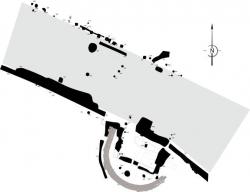 Hanoi - Traces of a huge water supply system and parallel ground wall from the time of the Ly dynasty have been unearthed at the former Thang Long Imperial Citadel in downtown Hanoi, archaeologists have announced. The findings were the first of their kind found in Vietnam and were heralded by most commentators and scientists as striking. "Never before have architectural vestiges from the Ly dynasty (11th to 13th century) been detected in the North Gate area and what was found proves the dynasty's architecture was quite imposing," said Tong Trung Tin, head of Vietnam Institute of Archaeology, at a workshop on Dec. 26. The water structure was about 2m wide and 2m high, archaeologists said. It was thought to have been a waterway, water tank, well, tunnel or spiritual work. It was built with square and rectangular bricks and timber poles in an east-west direction. The ground wall was 1.6m wide. "It is likely that this huge brick-made water line was part of a drainage system in the Forbidden City or a spiritual structure in accordance with the science feng shui in the Ly dynasty," Tin said. The workshop was held by Hanoi-Thang Long Heritage Conservation Centre and the Vietnam Institute of Archaeology to report on recent archaeological excavations at the Kinh Thien Palace area. In previous excavations, relics and artefacts from the Ly dynasty have been unearthed at the archaeological site at 18 Hoang Dieu Street , but no architectural remnants were found, the workshop was told. The new discovery would provide an insight into sanctums inside the imperial citadel. Also found at the 500sq.m wide by 4.2m deep excavation site at the North Gate were relics from the Tran, Early Le and Nguyen dynasties. They included flower decorations, drainage, foundation buttresses and brick foundations. Archaeologists said the findings, which lay at the very centre of Thang Long-Hanoi cultural axis, intertwined and overlapped over a thousand years. They recommended the diggings be covered to prevent damage and that further excavations be undertaken to provide more information.
Hanoi - Traces of a huge water supply system and parallel ground wall from the time of the Ly dynasty have been unearthed at the former Thang Long Imperial Citadel in downtown Hanoi, archaeologists have announced. The findings were the first of their kind found in Vietnam and were heralded by most commentators and scientists as striking. "Never before have architectural vestiges from the Ly dynasty (11th to 13th century) been detected in the North Gate area and what was found proves the dynasty's architecture was quite imposing," said Tong Trung Tin, head of Vietnam Institute of Archaeology, at a workshop on Dec. 26. The water structure was about 2m wide and 2m high, archaeologists said. It was thought to have been a waterway, water tank, well, tunnel or spiritual work. It was built with square and rectangular bricks and timber poles in an east-west direction. The ground wall was 1.6m wide. "It is likely that this huge brick-made water line was part of a drainage system in the Forbidden City or a spiritual structure in accordance with the science feng shui in the Ly dynasty," Tin said. The workshop was held by Hanoi-Thang Long Heritage Conservation Centre and the Vietnam Institute of Archaeology to report on recent archaeological excavations at the Kinh Thien Palace area. In previous excavations, relics and artefacts from the Ly dynasty have been unearthed at the archaeological site at 18 Hoang Dieu Street , but no architectural remnants were found, the workshop was told. The new discovery would provide an insight into sanctums inside the imperial citadel. Also found at the 500sq.m wide by 4.2m deep excavation site at the North Gate were relics from the Tran, Early Le and Nguyen dynasties. They included flower decorations, drainage, foundation buttresses and brick foundations. Archaeologists said the findings, which lay at the very centre of Thang Long-Hanoi cultural axis, intertwined and overlapped over a thousand years. They recommended the diggings be covered to prevent damage and that further excavations be undertaken to provide more information.
http://www.tuoitrenews.vn/cmlink/tuoitrenews/society/ancient-water-system-found-at-citadel-1.95352
MEXIQUE – 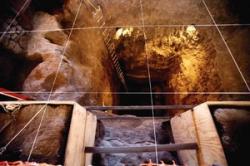 Teotihuacan - Le quotidien mexicain El Universal présente un article court mais très intéressant sur l'avancée des fouilles du Projet Tlalocan dirigé par l'archéologue Sergio Gómez. On y apprend que ce sont 76 m qui ont été dégagés sur les 120 m que compte le tunnel creusé puis rempli sous la Pyramide adossée et celle du Serpent à plumes. Cet article annonce également les objectifs du projet pour l'année prochaine : deux chambres latérales, détectées préalablement par géoradar seront explorées. Cependant Sergio Gómez se veut prudent : il espère que les fouilles permettront de corroborer ce qu'annonce l'analyse géoradar.
Teotihuacan - Le quotidien mexicain El Universal présente un article court mais très intéressant sur l'avancée des fouilles du Projet Tlalocan dirigé par l'archéologue Sergio Gómez. On y apprend que ce sont 76 m qui ont été dégagés sur les 120 m que compte le tunnel creusé puis rempli sous la Pyramide adossée et celle du Serpent à plumes. Cet article annonce également les objectifs du projet pour l'année prochaine : deux chambres latérales, détectées préalablement par géoradar seront explorées. Cependant Sergio Gómez se veut prudent : il espère que les fouilles permettront de corroborer ce qu'annonce l'analyse géoradar.
http://mexiqueancien.blogspot.fr/
ITALIE –  Rome - Caracalla bathsThe baths pulled in 5,000 bathers a day by archaeology - Amid the ruins of the Caracalla baths in Rome, there is a staircase that takes visitors deep into the ground. “This is our glimpse at maniacal Roman perfection, at incredible hydraulic technology,” says archaeologist Marina Piranomonte, as she descends and waves at a network of high and wide tunnels, each measuring six 20 feet high and wide, snaking off into the darkness. The baths, on a sprawling site slightly off the beaten track in a city crowded by monumental attractions, hold their own against the nearby Circus Maximus, its shattered walls standing 37 metres high, recalling its second century heyday when it pulled in 5,000 bathers a day. But for Piranomonte, it is the three kilometer, triple-tiered grid of tunnels that lies under the site – the first tract of which will open for visits this month – which really shows off how seriously the Romans took their sauna time. An army of hundreds of slaves kept firmly out of sight of bathers scurried along the tunnels feeding 50 ovens with tonnes of wood a day to heat water surging through a network of underground channels that arrived via aqueduct from a source 100km away. Below that, massive sewers flowed towards the Tiber. “It’s the dimension and the organisation that amazes – there is no spa as big as this anywhere in the world today. The emperor Caracalla was cruel, but he built beautiful things,” says Piranomonte. A €450,000 restoration programme also resulted in the reopening this month of an underground temple at the baths, linked to the tunnel network and dedicated to Mithras. “It was a cruel cult, for men only, so you understand why Christianity got the upper hand,” says Piranomonte.
Rome - Caracalla bathsThe baths pulled in 5,000 bathers a day by archaeology - Amid the ruins of the Caracalla baths in Rome, there is a staircase that takes visitors deep into the ground. “This is our glimpse at maniacal Roman perfection, at incredible hydraulic technology,” says archaeologist Marina Piranomonte, as she descends and waves at a network of high and wide tunnels, each measuring six 20 feet high and wide, snaking off into the darkness. The baths, on a sprawling site slightly off the beaten track in a city crowded by monumental attractions, hold their own against the nearby Circus Maximus, its shattered walls standing 37 metres high, recalling its second century heyday when it pulled in 5,000 bathers a day. But for Piranomonte, it is the three kilometer, triple-tiered grid of tunnels that lies under the site – the first tract of which will open for visits this month – which really shows off how seriously the Romans took their sauna time. An army of hundreds of slaves kept firmly out of sight of bathers scurried along the tunnels feeding 50 ovens with tonnes of wood a day to heat water surging through a network of underground channels that arrived via aqueduct from a source 100km away. Below that, massive sewers flowed towards the Tiber. “It’s the dimension and the organisation that amazes – there is no spa as big as this anywhere in the world today. The emperor Caracalla was cruel, but he built beautiful things,” says Piranomonte. A €450,000 restoration programme also resulted in the reopening this month of an underground temple at the baths, linked to the tunnel network and dedicated to Mithras. “It was a cruel cult, for men only, so you understand why Christianity got the upper hand,” says Piranomonte.
http://www.archaiologia.gr/en/blog/2012/12/28/caracalla-baths/
FRANCE – 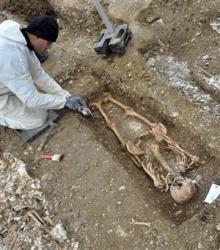 Dijon - Des centaines sinon des milliers de Côte-d’Oriens ont trouvé la mort à cause du choléra. C’était il y a 180 ans, à partir de 1832, date à laquelle la France connaît une vaste épidémie, et ce, jusqu’en 1854. La Côte-d’Or n’y échappera pas. Dijon, du fait qu’elle est la ville la plus peuplée du département, sera la plus touchée par la maladie, avec des centaines de dépouilles, inhumées au plus vite pour tenter de contenir la propagation des vibrions. A Dijon, un chantier archéologique ouvert il y a quelques semaines remet au goût du jour cette période noire de notre histoire départementale. Si le chantier dijonnais n’a en soi aucune valeur archéologique exceptionnelle, les analyses des dépouilles de cet ancien cimetière appartenant à l’hôpital général devraient quant à elles apporter nombre d’enseignements. « Tous les malades du choléra étaient placés là, à la va-vite, avec de la chaux, car, à l’époque des épidémies, on ne prenait pas le temps de dresser une sépulture digne de ce nom », souligne un ingénieur de l’Inrap. Début décembre, nous avons pu accéder au chantier archéologique, situé dans le quartier du Pont-des-Tanneries. Des dizaines de squelettes, dûment dépoussiérés, gisaient dans plusieurs fosses rectangulaires, dans un état de conservation variable, le plus souvent entourées de blocs de chaux. « La fouille des sépultures et la découverte d’individus qui sont morts du choléra, de la tuberculose ou de la typhoïde vont nous apporter des renseignements précieux sur les différentes épidémies de la période moderne, indiquait Carole Fossurier, archéologue et anthropologue. Cela présente un intérêt pour les paléopathologistes mais aussi pour la médecine actuelle. » Reste alors une question : les noms des personnes décédées ont-ils été enregistrés ? Est-il possible, aujourd’hui, de savoir qui a été inhumé dans ce cimetière ? « Sûrement, oui. Soit l’hôpital a conservé ces données, soit elles ont été transférées aux archives départementales », explique-t-on du côté de l’Inrap. Les archives justement. Les premières données accessibles rappellent que la propagation du choléra a été rapide et massive, l’eau « des lavoirs et des puits collectifs » étant l’un des vecteurs. On y apprend aussi que « poignées de mains et embrassades » favorisaient la transmission du choléra. Ou encore que les plus pauvres, du fait de leur habitat, de la promiscuité ou de leur régime alimentaire, appauvri, faisaient partie des populations à risques. Et donc victimes du choléra. D’autres foyers ont évidemment frappé la Côte-d’Or. On sait cependant que plus la densité était élevée, plus le nombre de morts du choléra était conséquent. « Il n’y a pas eu une épidémie mais plusieurs épidémies en Côte-d’Or », précise-t-on à l’Inrap. Ce que viennent compléter les archives départementales : « On assiste donc, en 1832 et en 1854, à l’extension des épidémies de choléra pendant les saisons chaudes. Celle de 1854 se répand en tache d’huile à partir de deux foyers : Haute-Marne/Haute-Saône et Bouches-du-Rhône, frappant sévèrement à la fois le nord-Est et le Midi. » En 1832, les décès pendant l’année avaient doublé. En 1854, ils avaient quadruplé.
Dijon - Des centaines sinon des milliers de Côte-d’Oriens ont trouvé la mort à cause du choléra. C’était il y a 180 ans, à partir de 1832, date à laquelle la France connaît une vaste épidémie, et ce, jusqu’en 1854. La Côte-d’Or n’y échappera pas. Dijon, du fait qu’elle est la ville la plus peuplée du département, sera la plus touchée par la maladie, avec des centaines de dépouilles, inhumées au plus vite pour tenter de contenir la propagation des vibrions. A Dijon, un chantier archéologique ouvert il y a quelques semaines remet au goût du jour cette période noire de notre histoire départementale. Si le chantier dijonnais n’a en soi aucune valeur archéologique exceptionnelle, les analyses des dépouilles de cet ancien cimetière appartenant à l’hôpital général devraient quant à elles apporter nombre d’enseignements. « Tous les malades du choléra étaient placés là, à la va-vite, avec de la chaux, car, à l’époque des épidémies, on ne prenait pas le temps de dresser une sépulture digne de ce nom », souligne un ingénieur de l’Inrap. Début décembre, nous avons pu accéder au chantier archéologique, situé dans le quartier du Pont-des-Tanneries. Des dizaines de squelettes, dûment dépoussiérés, gisaient dans plusieurs fosses rectangulaires, dans un état de conservation variable, le plus souvent entourées de blocs de chaux. « La fouille des sépultures et la découverte d’individus qui sont morts du choléra, de la tuberculose ou de la typhoïde vont nous apporter des renseignements précieux sur les différentes épidémies de la période moderne, indiquait Carole Fossurier, archéologue et anthropologue. Cela présente un intérêt pour les paléopathologistes mais aussi pour la médecine actuelle. » Reste alors une question : les noms des personnes décédées ont-ils été enregistrés ? Est-il possible, aujourd’hui, de savoir qui a été inhumé dans ce cimetière ? « Sûrement, oui. Soit l’hôpital a conservé ces données, soit elles ont été transférées aux archives départementales », explique-t-on du côté de l’Inrap. Les archives justement. Les premières données accessibles rappellent que la propagation du choléra a été rapide et massive, l’eau « des lavoirs et des puits collectifs » étant l’un des vecteurs. On y apprend aussi que « poignées de mains et embrassades » favorisaient la transmission du choléra. Ou encore que les plus pauvres, du fait de leur habitat, de la promiscuité ou de leur régime alimentaire, appauvri, faisaient partie des populations à risques. Et donc victimes du choléra. D’autres foyers ont évidemment frappé la Côte-d’Or. On sait cependant que plus la densité était élevée, plus le nombre de morts du choléra était conséquent. « Il n’y a pas eu une épidémie mais plusieurs épidémies en Côte-d’Or », précise-t-on à l’Inrap. Ce que viennent compléter les archives départementales : « On assiste donc, en 1832 et en 1854, à l’extension des épidémies de choléra pendant les saisons chaudes. Celle de 1854 se répand en tache d’huile à partir de deux foyers : Haute-Marne/Haute-Saône et Bouches-du-Rhône, frappant sévèrement à la fois le nord-Est et le Midi. » En 1832, les décès pendant l’année avaient doublé. En 1854, ils avaient quadruplé.
http://www.bienpublic.com/cote-d-or/2012/12/29/il-y-a-180-ans-le-cholera-frappait-la-cote-d-or
ROYAUME UNI – 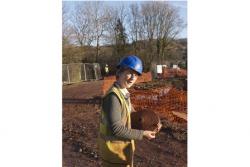 Kingskerswell - The fascinating finds emerged in advance of the construction of the South Devon Link Road, near Kingskerswell. The Roman settlement appears to have comprised a large rectangular ditched enclosure, which appears to have been modified three times, probably as a result of ever-increasing wealth and the construction of more elaborate buildings inside the enclosure. While no evidence for a building survives due to subsequent quarrying, some of the artefacts recovered give an indication of its quality. The archaeologists have found large quantities of pottery, some of which has come from as far afield as southern France and Spain, while that produced in Britain has come from Oxfordshire, Dorset, Hampshire and more locally South Devon. Pieces of stone and ceramic tile recovered hint at a highly Romanised building, with one of the more interesting discoveries being a piece of slate engraved on both sides with geometric decoration and one by an artist with great skill. The medieval building remains are located closer to the village and date from around the 13th century. These comprise well-constructed stone walls, as well as a trackway leading to the building from the main road. It is possible the building was perhaps abandoned at a time when the Black Death arrived in Britain.
Kingskerswell - The fascinating finds emerged in advance of the construction of the South Devon Link Road, near Kingskerswell. The Roman settlement appears to have comprised a large rectangular ditched enclosure, which appears to have been modified three times, probably as a result of ever-increasing wealth and the construction of more elaborate buildings inside the enclosure. While no evidence for a building survives due to subsequent quarrying, some of the artefacts recovered give an indication of its quality. The archaeologists have found large quantities of pottery, some of which has come from as far afield as southern France and Spain, while that produced in Britain has come from Oxfordshire, Dorset, Hampshire and more locally South Devon. Pieces of stone and ceramic tile recovered hint at a highly Romanised building, with one of the more interesting discoveries being a piece of slate engraved on both sides with geometric decoration and one by an artist with great skill. The medieval building remains are located closer to the village and date from around the 13th century. These comprise well-constructed stone walls, as well as a trackway leading to the building from the main road. It is possible the building was perhaps abandoned at a time when the Black Death arrived in Britain.
http://www.paigntonpeople.co.uk/Archaeologists-unearth-Roman-artefacts/story-17636325-detail/story.html
OMAN – 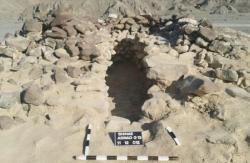 Aswad - A team of archaeologists at the Ministry of Heritage and Culture managed to unearth an archaeological site at the Aswad border Check Point area in the Wilayat of Shinas in North Al Batinah Governorate. The site includes a settlement and an archaeological symmetry that dates back to 2000 BC (Wadi Souq era) as per the archaeological surveys conducted by the ministry. The team unearthed the settlement and the archaeological cemetery while conducting the routine surveys before starting any public or private project. Rescue digging works are currently under way for some of the archaeological tombs due to the importance of this site. The digging works revealed a settlement of which the round stone foundations are remaining. The excavation works included a number of archaeological tombs of Wadi Souq era, oval, rectangular similar tombs which look like the ‘U’ letter. The tombs include body remains, head of arrows, daggers, knives, needles, brass necklaces, local and imported beads from the neighbouring cultures, clay utensils and soap stones. The excavation team is currently conducting surveys and documents of all the archaeological evidences at the perimeter of the sites.
Aswad - A team of archaeologists at the Ministry of Heritage and Culture managed to unearth an archaeological site at the Aswad border Check Point area in the Wilayat of Shinas in North Al Batinah Governorate. The site includes a settlement and an archaeological symmetry that dates back to 2000 BC (Wadi Souq era) as per the archaeological surveys conducted by the ministry. The team unearthed the settlement and the archaeological cemetery while conducting the routine surveys before starting any public or private project. Rescue digging works are currently under way for some of the archaeological tombs due to the importance of this site. The digging works revealed a settlement of which the round stone foundations are remaining. The excavation works included a number of archaeological tombs of Wadi Souq era, oval, rectangular similar tombs which look like the ‘U’ letter. The tombs include body remains, head of arrows, daggers, knives, needles, brass necklaces, local and imported beads from the neighbouring cultures, clay utensils and soap stones. The excavation team is currently conducting surveys and documents of all the archaeological evidences at the perimeter of the sites.
http://main.omanobserver.om/node/136015
CHINE – Huoluochaideng - Archaeologists have excavated about 3,500kg of ancient coins in China's Inner Mongolia Region, Xinhua reported on Sunday. Most of these coins were in prevalence during the Han dynasty (202 BC-220 AD). According to Lian Jilin, a researcher with the regional Institute of Cultural Relics and Archaeology, the coins were found in three millennia-old coin pits in the ancient town of Huoluochaideng after police cracked three theft cases. Most of the coins were "Huoquan", the coins commonly used in the Han dynasty (202 BC-220 AD), said Lian. Archaeologists also excavated over 100 casting moulds from the relics of a coin workshop. The moulds are believed to date back to the rule of Emperor Wudi (156 BC-87 BC) of the Western Han Dynasty and the short-lived Xin Dynasty (45 BC-23 AD) founded by Wang Mang. Based on its size and cultural relics uncovered there, Huoluochaideng town is believed to have been a major town in northern China during the Han Dynasty, said Lian. The findings are significant in the study of the ancient monetary system and casting technology, he added.
http://timesofindia.indiatimes.com/world/china/Huge-quantity-of-ancient-coins-found-in-China/articleshow/17820132.cms